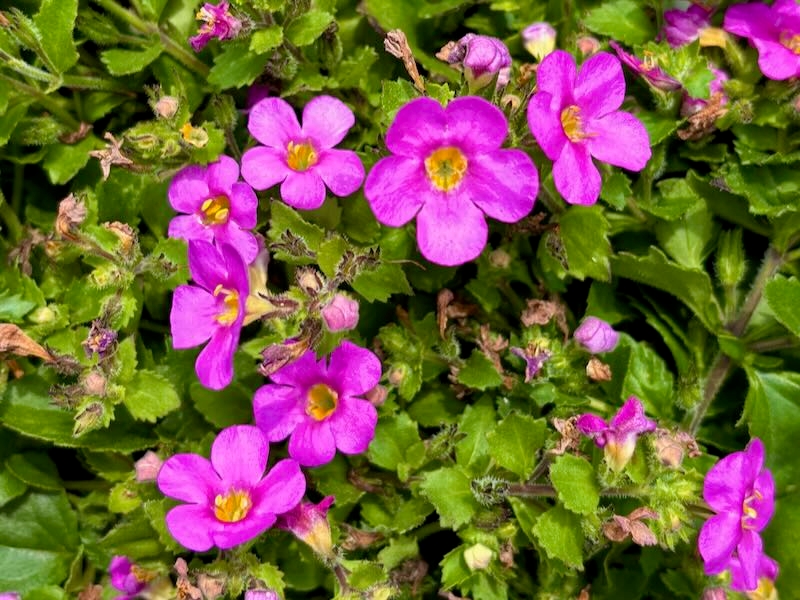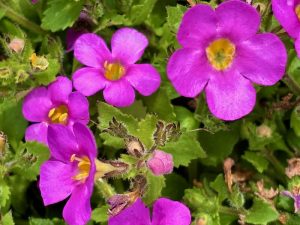Sutera ‘Abunda™ Pink’: The Cascading Beauty That Never Stops Blooming
Sutera ‘Abunda™ Pink’ brings steady color, tidy habit, and easy care to hanging baskets, mixed containers, and sunny edging. Gardeners call it Bacopa, and it belongs to the Plantaginaceae family. Ball Floraplant developed the Abunda™ series to give growers a more upright, better-branched bacopa with larger flowers. Sutera ‘Abunda™ Pink’ produces loads of candy-pink, five-petaled blooms from spring to fall and spreads a forgiving carpet of glossy green foliage. Plant it where you want continuous pastel color and low fuss maintenance.
Sutera ‘Abunda™ Pink’: quick overview
Sutera ‘Abunda™ Pink’ shows off small, rounded leaves and a loose, trailing habit that also carries an upright element. Expect plants to reach roughly 15–30 cm (6–12 in) tall with a spread of 30–60 cm (12–24 in) when grown in containers or beds. The flowers measure about 2–3 cm (¾–1¼ in) across and display a darker eye in the center that adds depth to each blossom. The plant flowers freely from late spring until the first hard frost in cooler climates. In USDA Zones 9–11 you can treat it as a tender perennial; elsewhere gardeners grow it as a long-flowering annual.
Why choose Sutera ‘Abunda™ Pink’?
Choose Sutera ‘Abunda™ Pink’ when you want a low-maintenance spiller with big floral impact. It offers continuous color, fills containers rapidly, and layers nicely with taller focal plants. Moreover, this series performs better in bright conditions than older bacopas because breeders selected for stronger branching and larger blooms. Use it to soften edges, trail from hanging baskets, or create a frothy groundcover where a neat, pink carpet fits the design.
How to Grow Sutera ‘Abunda Pink’
Plant it right and the season will reward you with nonstop flowers. Below I cover light, soil, watering, fertilizing, pruning, and winter care in short, actionable steps.
Light
Place Sutera ‘Abunda™ Pink’ in full sun to part shade. It blooms best with at least 4–6 hours of direct sun. However, provide afternoon shade in very hot climates. Too much deep shade reduces flowering and makes stems leggy. Therefore, plant it where morning sun wakes the blooms and afternoon shade protects them in heat.
Soil and potting
Use a well-draining, humus-rich soil. For ground planting, amend heavy clay with compost and coarse sand to open the soil. For containers choose a premium potting mix with added perlite or bark to aid drainage. Plant the crown at the same level it grew in the nursery pot. Fill containers large enough to hold moisture—20–30 cm (8–12 in) diameter for a single plant in a showy arrangement—and allow room for 2–3 plants in medium-sized baskets.
Watering
Keep the soil consistently moist. Water deeply so the root zone stays damp but not waterlogged. For container culture, check the top 2–3 cm (about 1 in) of mix daily in warm weather and water when that layer dries. During heat waves you may need to water once a day. Conversely, reduce watering in cool, wet weather. Avoid overhead watering late in the day; wet foliage at night invites fungal issues. Instead, water in the morning and let leaves dry quickly.
Fertilizing
Feed Sutera ‘Abunda™ Pink’ regularly to sustain heavy blooming. Apply a balanced, water-soluble fertilizer every 10–14 days during the main season. Alternatively, use a slow-release granular fertilizer at planting and supplement with liquid feed for containers. If flowers thin out, increase feed frequency for two to three applications and then return to a steady schedule.
Pruning and maintenance
Prune lightly to encourage fullness. Pinch back long stems in early summer to promote branching and more flowers. Remove any leggy or brown growth as you find it. The Abunda series cleans itself well, so you do not need to deadhead; instead, trim lightly to refresh the shape and encourage a second wind of blooms.
Winter care
In mild climates (USDA Zones 9–11) you can leave plants in place as semi-perennials. In colder climates treat Sutera‘Abunda Pink’ as an annual and remove spent plants after frost. If you grow in containers, bring them indoors before the first hard freeze or take soft tip cuttings to overwinter in a bright, cool room to restart in spring.
Propagation of Sutera ‘Abunda™ Pink’
Propagate by tip cuttings for the fastest, most reliable results. Take 5–8 cm (2–3 in) long tips from healthy growth. Strip the lower leaves and place cuttings in a sterile mix of perlite and peat or in rooting cubes. Keep the medium moist and the humidity high under a clear dome or plastic bag. Provide bright, indirect light and warmth around 18–24 °C (65–75 °F). Roots form in two to four weeks. You can also sow seeds, but many commercial varieties produce hybrids and seed-grown plants may not match the parent.
Pests and Diseases
Sutera ‘Abunda™ Pink’ stays relatively trouble-free when you manage water and airflow. Watch for these common issues and act quickly.
Aphids: These soft-bodied insects cluster on new growth. Blast them off with water or use insecticidal soap.
Whiteflies and thrips: Monitor with sticky traps and treat infested plants with targeted biological or soap sprays.
Spider mites: Heat and dry conditions favor mites. Increase humidity and hose the foliage to reduce populations.
Botrytis (gray mold): Overcrowding and wet, cool nights lead to gray fuzzy mold on flowers. Remove affected parts and improve spacing and airflow.
Root rot: Poor drainage and constant saturation cause root rot. Repot into fresh, well-draining mix and cut away mushy roots if you catch it early.
Encourage beneficial insects by planting nectar sources nearby. They keep pest pressure low and help the bacopa perform at its best.
Flowering season, growth habit, and tolerances
Sutera ‘Abunda™ Pink’ or Bacopa flowers from late spring through autumn in most gardens. In frost-free areas the display can continue nearly year-round. The growth habit blends trailing stems with a slightly more upright branching than older bacopas. Therefore, the plant fills hanging baskets and spills attractively over container rims while still showing a neat mound at the crown.
The cultivar tolerates heat and humidity better than many older bacopas. However, in extreme heat above 35 °C (95 °F) provide afternoon shade and extra water. Protect it from strong drying winds, which desiccate small leaves quickly. Avoid frost; plants survive down to about 0–2 °C (32–36 °F) briefly but suffer damage with hard freezes.
Design ideas and companion plants
Place Sutera ‘Abunda™ Pink’ where its soft pink will sing against darker foliage and structural forms. It pairs beautifully with:
- Trailing petunias or calibrachoa for a lush basket with layered color.
- Upright salvias, snapdragons, or grasses to give vertical contrast behind the spill.
- Silver-leaved plants such as dusty miller or artemisia to cool the palette and set off the pink.
- Lavender or rosemary at the rear edge for a fragrant companion that also attracts pollinators.
In mixed containers, plant Sutera ‘Abunda™ Pink’ at the edge as a spiller, place a mid-height filler like lobelia or diascia in the centre, and use a tall thriller such as a small salvia or ornamental grass behind.
Troubleshooting common problems
Problem: Flowers drop and plant looks sparse.
Action: Check soil moisture and fertilizer. Underwatering and nutrient depletion cause bud and flower drop. Water consistently and resume regular feeding.
Problem: Leggy stems and few blooms.
Action: Move the plant to a brighter site, pinch back stems to encourage branching, and reduce nitrogen-heavy feeds that favor leaf over flower.
Problem: Brown leaf edges in heat.
Action: Give afternoon shade, increase watering, and add mulch to keep roots cool.
Problem: Yellow leaves with green veins.
Action: Test soil pH. Bacopas prefer slightly acidic to neutral pH (around 5.5–7.0). Correct pH slowly with organic matter and avoid excess alkalinity.
Seasonal care calendar (quick reference)
Spring: Plant after last frost. Apply a slow-release fertilizer and water regularly. Pinch to encourage branching.
Summer: Maintain consistent moisture, feed every 10–14 days, and provide afternoon shade if needed.
Autumn: Reduce fertilizing as temperatures cool. In cold regions, remove and compost spent plants after frost.
Winter (mild areas): Cut back and refresh containers. Overwinter cuttings indoors if needed.
Final notes on success
Sutera ‘Abunda™ Pink’ commonly known as Bacopa rewards attentive gardeners with long-lasting color and little drama. Plant it in well-drained mix, feed it regularly, and place it where morning sun reaches the leaves. Deadheading proves unnecessary, but light pruning keeps plants neat and encourages more blooms. For cuttings and quick fills, take tip cuttings and root them in standard mixes. Offer protection from frost and from hot afternoon sun in very warm climates.
Plant it in a hanging basket, and your porch will wear a soft pink skirt all summer. Place it as a border in a perennial bed, and it will hold the edge with steady color. Try a trio of containers with Sutera ‘Abunda™ Pink’ spilling over the sides and taller companions rising from the center. In short, use Sutera ‘Abunda Pink’ whenever you want generous, low-effort blooms that look good up close and from across the yard.



